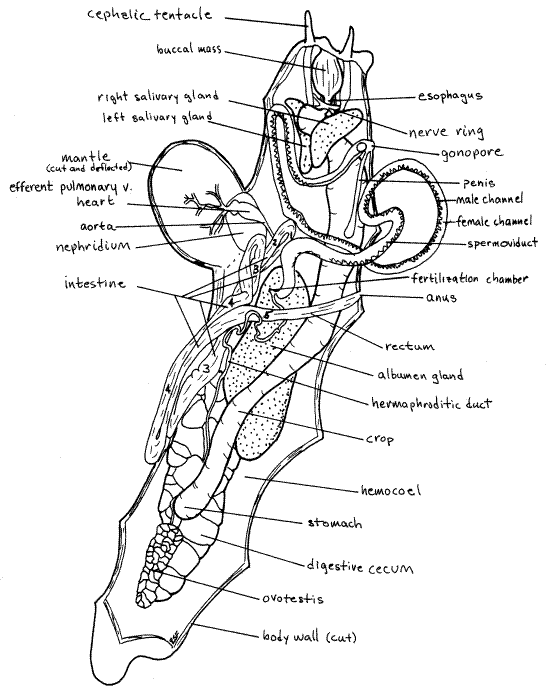I'd been finding excrement left by our slugs (Lehmannia valentiana) all over the yard, but a couple of days ago I actually observed defecation take place. Now, you may think that this interest in slug excrement is another symptom of my obsession. Haha, you may be right! But I'm going to talk about it anyway.
To start off, let's review the anatomy of a slug's digestive system. Richard Fox of Lander University writes of Limax maximus:
"The muscular, ovoid mass filling most of the space in center of the head is the buccal mass...Inside the buccal mass you will find the lumen of the pharynx, into which the mouth opens. A large chitinous jaw with lateral teeth on each side arches over the lumen of the pharynx and may protrude from the mouth. The flexible, transparent, rasplike radula is located on the floor of the pharynx...A narrow, short esophagus emerges from the posterior end of the dorsal buccal mass...The two salivary gland ducts enter the gut laterally at the junction between the esophagus and pharynx...Posterior to the nerve ring the esophagus empties into the...crop. (In Ariolimax and Arion the intestine and digestive cecum spiral around the crop and obscure your view of it.) The contents of the crop are seen clearly through its walls, making it the color of the slug's most recent meal. The crop extends posteriorly to the anterior end of the ovotestis where it expands slightly to become the short stomach...(In Ariolimax and Arion the stomach is well posterior to the ovotestis, in about the middle of the digestive ceca. It is a...pouch with crop and intestine attached to its anterior end. The large ducts from the digestive gland empty into it.) The posterior crop and stomach are surrounded by the two large, lobed digestive ceca...Large ciliated ducts from the ceca communicate with the stomach. Intracellular digestion occurs in the ceca...The intestine exits the left side of the stomach...[and] empties at the anus...The rectum...begins on the left and crosses the hemocoel to the anus on the right [near the pneumostome]."
He then discusses the excretory system of Limax maximus:
"The...nephridium, or kidney, is the most conspicuous structure in the lung...The...ureter...exits the posterior right end of the nephridium and extends to the nephridiopore beside the anus...[which is] on the inside of the dorsal lip of the pneumostome. It is a large slit. You can also see the rectum running a short distance across the roof of the posterior right lung to enter the visceral mass. The rectum crosses the roof of the cavity obliquely to reach the anus...The ureter runs beside the rectum and opens via the nephridiopore near the anus."
Here is the diagram I've shown before, drawn by Fox:
 |
| © 2001 Richard Fox, Lander University http://lanwebs.lander.edu/faculty/rsfox/invertebrates/limax.html |
No comments:
Post a Comment